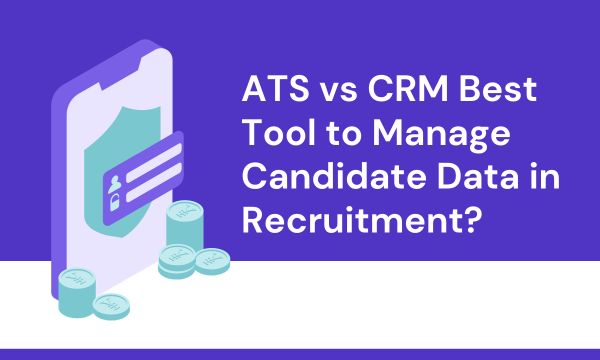In the world of recruitment, the acronyms “ATS” and “CRM” are frequently mentioned, but what do they really mean, and how do they differ? Both are essential tools for managing candidate data, but they serve distinct purposes. Let’s delve into the differences between Applicant Tracking Systems (ATS) and Customer Relationship Management (CRM) systems to gain a better understanding of when and how to use each one.
What is Applicant Tracking System (ATS)
An Applicant Tracking System, or ATS, is a software application designed to streamline the hiring process by managing job postings, receiving and sorting applications, and facilitating communication between recruiters and candidates.
Key Features of an ATS
- Application Management: ATS systems excel at handling the influx of candidate applications. They organize, store, and categorize resumes and other application materials efficiently.
- Resume Parsing: ATS software can automatically extract relevant information from resumes, making it easier to match candidates with job openings.
- Candidate Pipeline: ATS systems provide a structured pipeline to track candidates’ progress through various hiring stages, from initial application to final selection.
- Compliance and Reporting: They help ensure compliance with hiring regulations, such as equal opportunity laws. ATS also offer reporting capabilities to assess hiring metrics and progress.
- Job Posting: ATS platforms allow for easy posting of job openings to multiple job boards and websites.
What is Customer Relationship Management (CRM)
A Customer Relationship Management system, or CRM, originally designed for sales and marketing, has been adapted for recruitment as well. A recruitment CRM focuses on maintaining and nurturing relationships with candidates, building a talent pool, and improving the overall candidate experience.
Key Features of a Recruitment CRM
- Efficient Candidate Sourcing and Tracking: CRM systems are designed for proactive candidate sourcing. They enable you to source, store, and maintain candidate data, including resumes, social profiles, and communication history for future reference.
- Communication and Relationship Building: CRM platforms facilitate personalized communication with candidates. They offer features like automated emails, follow-up reminders, and targeted messages to maintain strong candidate relationships.
- Streamlined Hiring Process: A CRM helps automate routine tasks such as interview scheduling and follow-ups, enhancing the efficiency of the hiring process.
- Data Analytics: CRM systems provide data analytics capabilities, allowing you to track important metrics such as candidate sources, response rates, and time-to-hire. These insights help with data-driven decision-making.
- Integration: Recruitment CRMs can often integrate with other HR systems, creating a more comprehensive ecosystem for human resources operations.
Choosing Between ATS and CRM
The choice between an ATS and a CRM largely depends on your organization’s recruitment goals and strategies:
- ATS is ideal when you need to efficiently manage a high volume of candidate applications, maintain structured hiring processes, and ensure compliance with hiring regulations.
- CRM is best suited for building and nurturing relationships with candidates, proactively sourcing talent, and leveraging data analytics for future recruitment strategies.
In many cases, organizations opt to use both systems in combination to maximize the benefits of each. This provides a comprehensive recruitment strategy that effectively manages candidate data at all stages of the hiring process.
The Role of Recruitment CRM in Managing Candidate Data
managing candidate data efficiently is essential for success. Recruitment Customer Relationship Management (CRM) systems have emerged as powerful tools to streamline the candidate management process.
Recruitment CRM: Nurturing and Leveraging Candidate Relationships
Recruitment CRM is a specialized software designed to optimize the management of candidate data. Its primary focus is on building, nurturing, and leveraging candidate relationships. Here’s how it accomplishes this:
- Efficient Candidate Sourcing and Tracking: A recruitment CRM allows recruiters to proactively source and track candidate data, such as resumes, social profiles, and communication history. It’s essentially a treasure trove of talent waiting to be tapped when new job openings arise.
- Personalized Communication: CRM systems empower recruiters to communicate with candidates in a personalized manner. Features like automated emails, follow-up reminders, and targeted messaging enhance engagement and foster strong candidate relationships.
- Streamlined Hiring Process: Automation is a hallmark of CRM systems. Tasks like interview scheduling and follow-ups can be automated, saving valuable time and creating a well-organized hiring process.
- Data Analytics for Informed Decisions: Recruitment CRMs provide invaluable insights through data analytics. Recruiters can track critical metrics, such as candidate sources, response rates, and time-to-hire, enabling data-driven decision-making and continuous improvement of recruitment strategies.
- Integration for Seamless Operations: Many CRM systems can integrate with other HR software, such as payroll, onboarding, and performance management, creating a seamless ecosystem for HR operations. This integration ensures that candidate data flows smoothly across various stages of the employment lifecycle.
Applicant Tracking System vs. Recruitment CRM: A Comparative Overview
While both Applicant Tracking Systems (ATS) and Recruitment CRM systems are vital in managing candidate data, they serve different purposes. Here’s a brief comparison of their roles:
- ATS is primarily designed to handle the management of candidate applications during the hiring process. It excels in tasks such as application tracking, resume parsing, and compliance management.
- Recruitment CRM, on the other hand, focuses on the entire candidate journey. It starts by proactively sourcing candidates, building relationships, and extends beyond the hiring process to maintain candidate relationships for future opportunities.
The Power of Candidate Databases
One of the defining features of a recruitment CRM is the candidate database. This centralized repository of candidate information not only eases the management of candidate data but also transforms it into a strategic asset for future hiring needs. Recruiters can tap into this database to quickly identify potential candidates for new positions, reducing time-to-hire and improving the overall quality of hires.
Recruitment CRM systems play a vital role in managing candidate data. They facilitate efficient sourcing, personalized communication, process automation, data-driven decision-making, and seamless integration with other HR systems. Understanding the role of a recruitment CRM and how it differs from ATS is essential for modern recruiters looking to optimize their candidate management processes and build lasting candidate relationships.
Benefits of Using a Recruitment CRM for Managing Candidate Data
Recruitment Customer Relationship Management (CRM) systems have become a game-changer in the world of recruitment by offering a host of benefits for managing candidate data. Here are the key advantages of using a recruitment CRM.
Efficient Candidate Sourcing and Tracking:
- Talent Pool Creation: Recruitment CRMs enable you to proactively source and build a comprehensive talent pool. You can gather and organize candidate data, including resumes, contact information, and skills, making it easily accessible for future job openings.
Also Read: Applicant Tracking Software vs. Recruitment Agencies: Which Is Better?
- Quick Candidate Identification: With a well-maintained candidate database, you can swiftly identify suitable candidates for specific roles, significantly reducing the time and effort required for sourcing.
Better Communication and Relationship Building with Candidates
- Personalized Engagement: CRM systems facilitate personalized communication with candidates. You can send targeted messages, automated emails, and follow-up reminders, ensuring candidates feel valued and engaged throughout the recruitment process.
- Strong Candidate Relationships: By nurturing relationships with candidates over time, recruitment CRMs help you maintain a network of potential talent, even if they aren’t selected for a current position.
Streamlined Hiring Process and Workflow Automation
- Efficient Task Management: Automation features in recruitment CRMs simplify and streamline tasks such as interview scheduling, candidate follow-ups, and document sharing. This leads to a well-organized and efficient hiring process.
- Enhanced Collaboration: CRMs often come with collaboration tools that enable team members to work seamlessly together on candidate evaluations, making the entire process more collaborative and effective.
Data Analytics for Better Decision Making
- Insightful Metrics: Recruitment CRMs offer data analytics capabilities that provide valuable insights into your recruitment process. Metrics like candidate sources, response rates, and time-to-hire can be tracked, allowing for informed and data-driven decision-making.
- Continuous Improvement: By analyzing these metrics, you can identify areas for improvement, optimize your recruitment strategy, and make well-informed decisions that contribute to a more successful hiring process.
Integration with Other HR Systems for Seamless Operations
- Holistic HR Ecosystem: Many recruitment CRMs can integrate with other HR systems, creating a unified ecosystem for HR operations. This integration ensures smooth data flow across various HR functions, from onboarding to performance management.
- Reduced Data Redundancy: Integration eliminates the need for duplicate data entry, reducing the chances of errors and ensuring that candidate data remains consistent across all HR systems.
In summary, a recruitment CRM is a powerful tool that revolutionizes candidate data management in recruitment. Its benefits extend beyond just data organization; it fosters candidate relationships, streamlines hiring processes, provides valuable insights through data analytics, and integrates seamlessly with other HR systems. Utilizing a recruitment CRM can lead to a more efficient and effective recruitment process while enhancing the quality of hires and overall candidate experience.
The Advantages of Using an Applicant Tracking System (ATS)
Applicant Tracking Systems (ATS) have long been a staple in the world of recruitment, and for good reason. These systems offer a range of benefits that make them indispensable for managing candidate applications. In this section, we’ll explore the advantages of using an ATS and its differentiating features.
Efficient Candidate Application Management
ATS software is specifically designed to manage and organize candidate applications effectively. Here’s how it accomplishes this:
- Automated Application Sorting: ATS systems can automatically sort and categorize incoming applications based on specific criteria, such as qualifications, experience, or keywords. This feature simplifies the initial screening process and ensures that only relevant applications reach the recruiters’ attention.
- Time Savings: With an ATS, recruiters can process a large volume of applications quickly, reducing the time and effort required to review each one individually. This leads to a more efficient and streamlined hiring process.
Resume Parsing
ATS systems often include resume parsing capabilities, which extract important information from resumes and input it into predefined fields. This feature simplifies the data entry process and ensures that critical information is consistently captured.
Structured Candidate Pipeline
ATS platforms typically offer a structured candidate pipeline that allows recruiters to track candidates’ progress through various stages of the hiring process. This structured approach helps recruiters stay organized and ensures that candidates don’t fall through the cracks.
Compliance and Reporting
ATS systems are designed to help organizations adhere to hiring regulations and standards. They often include features that support equal opportunity and diversity initiatives. Additionally, ATS platforms provide reporting capabilities that enable organizations to track and analyze their hiring metrics for continuous improvement.
Differentiating Features of an ATS
One of the key differentiating features of an ATS is its focus on candidate application management and screening. ATS excels in the following areas:
Job Posting and Application Tracking
ATS systems make it easy to post job listings on various platforms and efficiently track incoming applications. This ensures that job openings reach a wide audience and applications are systematically collected.
Also Read: How to Make the Most of Your Data
Resume Parsing
ATS platforms can parse resumes to extract relevant information such as contact details, education, work experience, and skills. This simplifies the process of candidate data entry and enhances the consistency and accuracy of candidate information.
Candidate Pipeline Management
ATS systems provide a visual representation of the candidate pipeline, allowing recruiters to track candidates’ progress from application submission to final selection. This transparency ensures that candidates are not overlooked and keeps the recruitment process on track.
Conclusion
In the realm of recruitment, choosing the right tool to manage candidate data can be a pivotal decision for any organization. As we’ve explored in this article, both Applicant Tracking Systems (ATS) and Recruitment Customer Relationship Management (CRM) systems offer a range of advantages and unique features to address distinct needs throughout the recruitment process. Understanding the differences and strengths of each system is crucial for making an informed decision.
Recruitment CRM systems excel in nurturing candidate relationships, sourcing talent, and providing a holistic approach to candidate data management. Their focus on personalized communication, automation, and data analytics ensures that organizations can build lasting connections with candidates and leverage valuable insights for future recruitment strategies.
On the other hand, ATS systems are the go-to choice for efficiently managing candidate applications. They streamline the initial screening process, automate application sorting, and offer a structured pipeline for tracking candidates through various hiring stages. ATS systems are indispensable when dealing with high volumes of applications and ensuring compliance with hiring regulations.
In many cases, the best solution may involve a combination of both ATS and CRM systems, creating a comprehensive approach to managing candidate data from application to relationship building and future opportunities.
Ultimately, the choice between ATS and CRM comes down to the specific recruitment goals and needs of the organization. An informed decision based on the unique requirements and priorities of your recruitment process will lead to a more efficient and effective candidate data management strategy. Whether it’s an ATS, a CRM, or a blend of both, these tools play a pivotal role in modern recruitment, contributing to better hires and a more streamlined, candidate-centric experience.




Comments are closed, but trackbacks and pingbacks are open.